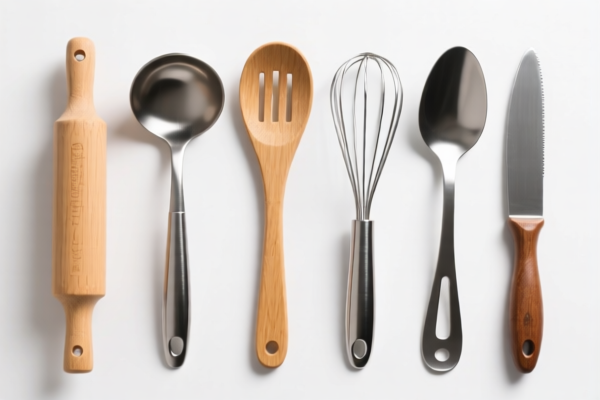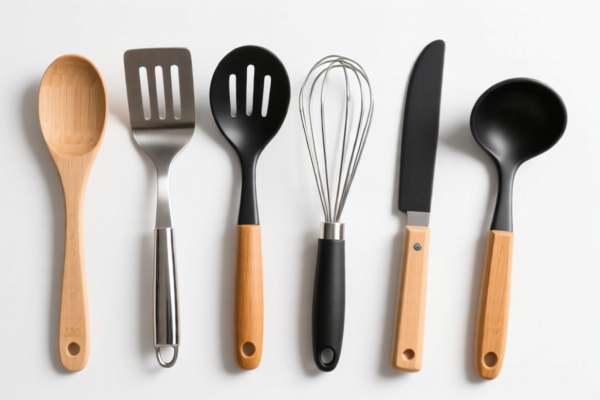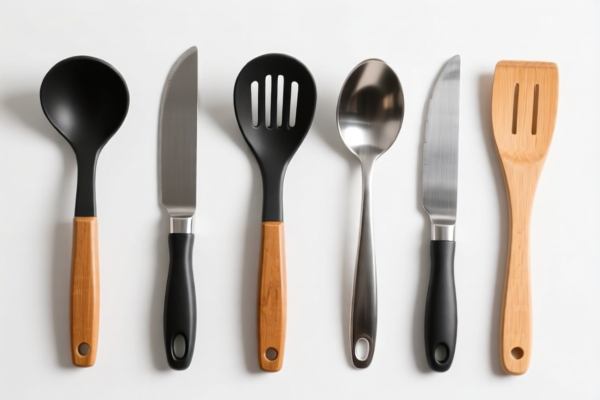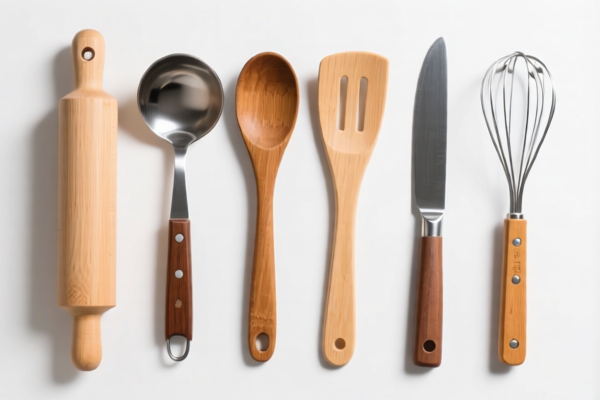| HS Code | Official Doc | Tariff Rate | Origin | Destination | Effective Date |
|---|---|---|---|---|---|
| 7323930035 | Doc | 82.0% | CN | US | 2025-05-12 |
| 3924104000 | Doc | 33.4% | CN | US | 2025-05-12 |
| 3924102000 | Doc | 44.0% | CN | US | 2025-05-12 |




Baking Utensils
Baking utensils encompass a wide array of tools, equipment, and cookware specifically designed for the preparation of baked goods. These items facilitate processes like mixing, measuring, shaping, decorating, and transferring baked items.
Materials
Baking utensils are constructed from diverse materials, each possessing unique properties. Common materials include:
- Stainless Steel: Durable, non-reactive, and easy to clean. Frequently used for mixing bowls, measuring cups, and cooling racks.
- Aluminum: Lightweight, excellent heat conductor. Commonly used for baking pans, though it can react with acidic ingredients. Anodized aluminum is non-reactive.
- Silicone: Flexible, heat-resistant, and non-stick. Used for baking pans, spatulas, and molds.
- Glass: Heat-resistant and allows for visual monitoring of baking progress. Used for baking dishes, pie plates, and measuring cups. Borosilicate glass is particularly resistant to thermal shock.
- Wood: Often used for rolling pins, spoons, and pastry boards. Requires careful cleaning and maintenance.
- Plastic: Lightweight and inexpensive, but may not withstand high temperatures or be as durable as other materials.
Purpose and Function
The primary purpose of baking utensils is to assist in the creation of baked goods, offering precision and efficiency. Key functions include:
- Mixing: Bowls, whisks, spoons, and mixers combine ingredients.
- Measuring: Cups, spoons, and scales accurately determine ingredient quantities.
- Shaping: Rolling pins, cookie cutters, and molds define the form of baked goods.
- Preparation: Pastry brushes apply liquids, and peelers prepare fruits and vegetables.
- Transferring: Spatulas, tongs, and baking sheets move baked goods.
- Decoration: Piping bags, decorating tips, and sprinkles add finishing touches.
Usage Scenarios
Baking utensils are used in a range of environments, including:
- Home Baking: For personal use in preparing cakes, cookies, breads, and other treats.
- Professional Bakeries: Commercial-grade utensils used for large-scale production.
- Pastry Shops: Specialized tools for creating delicate pastries and desserts.
- Culinary Schools: Educational settings for teaching baking techniques.
Common Types
A comprehensive list of common baking utensils includes:
- Mixing Bowls: Available in various sizes and materials.
- Measuring Cups and Spoons: Essential for accurate ingredient measurement.
- Whisks: Used for incorporating air and blending ingredients.
- Spatulas: Flexible tools for scraping and folding.
- Rolling Pins: For flattening dough.
- Baking Pans: Cake pans, loaf pans, pie plates, muffin tins, cookie sheets.
- Cookie Cutters: For creating decorative shapes.
- Piping Bags and Tips: For decorating cakes and pastries.
- Pastry Brushes: For applying egg washes and glazes.
- Cooling Racks: For allowing baked goods to cool evenly.
- Pastry Blender: For cutting fat into flour.
- Bench Scraper: For dividing and moving dough.
- Kitchen Scale: For precise ingredient measurement, particularly in bread making.
- Thermometer: For checking the internal temperature of baked goods.
- Sifter: For removing lumps and aerating dry ingredients.
- Zester/Grater: For preparing citrus zest and other ingredients.
- Pastry Wheel: For cutting dough and pastry.
- Dough Scraper: For working with dough.
- Cake Tester/Toothpick: For checking cake doneness.
- Cookie Scoop: For uniform cookie portioning.
- Muffin Liners: For easy muffin removal.
- Baking Stones: For achieving a crispy crust on breads and pizzas.
- Pie Shield: Prevents pie crust from burning.
- Basting Brush: For applying liquids to baked goods.
- Decorating Combs/Smoothers: For creating decorative patterns.
- Cake Leveler: For creating even cake layers.
This is not an exhaustive list, but it covers the most commonly used tools in baking. The specific utensils required will depend on the type of baking being undertaken.
BAKINGUTENSILS Classification
Based on the provided information, the following HS codes are relevant to BAKINGUTENSILS:
-
7323930035: This HS code falls under Chapter 73, which covers articles of iron or steel. Specifically, it relates to table, kitchen or other household articles and parts thereof, of iron or steel; iron or steel wool; pot scourers and scouring or polishing pads, gloves and the like, of iron or steel. The subheading 930035 further specifies "Other: Of stainless steel Cooking and kitchen ware: Other: Cooking ware: Bakeware (cookware not suitable for stove top use)". This code applies to bakeware made of stainless steel that is not designed for direct stove top heating. The total tax rate associated with this code is 82.0%, comprising a 2.0% base tariff, a 0.0% additional tariff, and a 30.0% additional tariff effective April 2, 2025, plus a 50% additional tariff on steel and aluminum products.
-
3924104000: This HS code is categorized under Chapter 39, which covers plastics and articles thereof. It specifically refers to tableware, kitchenware, other household articles and hygienic or toilet articles, of plastics. The subheading 104000 denotes "Tableware and kitchenware: Other". This code would apply to bakeware made of plastic. The total tax rate for this code is 33.4%, consisting of a 3.4% base tariff and a 30.0% additional tariff effective April 2, 2025.
-
3924102000: Also under Chapter 39 (plastics and articles thereof), this HS code covers tableware, kitchenware, other household articles and hygienic or toilet articles, of plastics. The subheading 102000 specifically identifies "Tableware and kitchenware: Plates, cups, saucers, soup bowls, cereal bowls, sugar bowls, creamers, gravy boats, serving dishes and platters". This code would be applicable to plastic bakeware items falling within these specific categories. The total tax rate is 44.0%, with a 6.5% base tariff and a 7.5% additional tariff, plus a 30.0% additional tariff effective April 2, 2025.
Customer Reviews
I loved how the page clearly explained the differences between the HS codes for stainless steel, plastic, and other materials. It made the export process much less confusing for me.
The HS code classification section was well-organized, but I had to double-check some of the tax rates against other sources. Still, it was a good starting point for my research.
The list of common baking utensils was extremely helpful. It gave me a clear idea of what tools are essential for different baking scenarios, especially for home bakers.
The page had good information on the materials used in baking utensils. I wish there was more on how to choose the right HS code based on the material, but it was still very informative.
The detailed explanation of HS code 3924102000 was exactly what I needed. It clearly outlined the categories for plastic bakeware and the applicable tax rates.